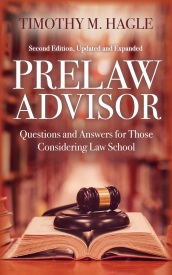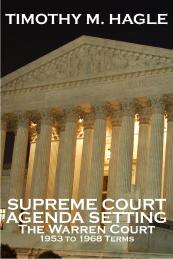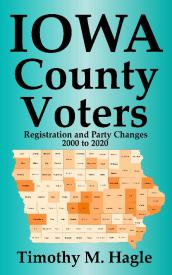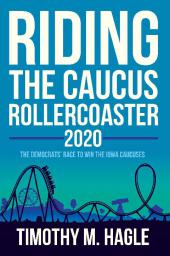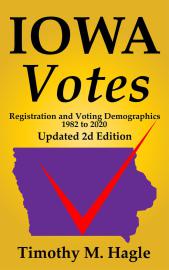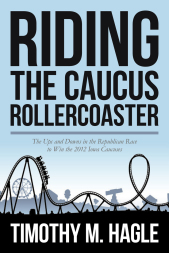
Contact Info
347 Schaeffer Hall
319-335-2348
timothy-hagle@uiowa.edu
Twitter: @ProfHagle
Fall 2024 Office Hours
Tue & Th: 4:45-6:15
Mailing Address
Dept of Political Science
341 Schaeffer Hall
20 E. Washington Street
The University of Iowa
Iowa City, Iowa 52242
News
Posted updated Prelaw FAQ for UI students
New Book, Riding the Caucus Rollercoaster 2024, published in paperback and for Kindle devices.
Posted updates to 12 papers in Iowa Voting Series for 2022 election data
New Book, Supreme Court Agenda Setting: The Warren Court, published for Kindle devices and computers with Kindle reader.
Published updated and expanded edition of Prelaw Advisor in paperback and for Kindle readers
My books
Supreme Court Agenda Setting: The Vinson Court (1946 to 1952 Terms)
The papers that follow are a series of papers I wrote regarding agenda setting on the Vinson Court. As each paper was completed updates and corrections may have changed some of the specific numbers presented in earlier papers, but the general results did not change. The papers were eventually combined into a book titled, Supreme Court Agenda Setting: The Vinson Court (see the link below). The individual papers became chapters in the book and the updated numbers were used for that version.
Again, the papers that follow are the original versions. Some numbers may have been updated for the version included as a chapter in the book version, but the changes were usually minor and did not affect the overall results.
Circuit Differences in Agenda Setting on the Vinson Court (Paper 1)
Agenda setting of the United States Supreme Court is a matter of continuing interest to judicial scholars. Previous studies have examined several aspects of the agenda setting process. These studies have usually focused on specific issues, particular terms, or sampling for their data collection. A more comprehensive examination of the cases filed before the Supreme Court will provide a clearer picture of how the justices set their agenda. To that end, this study will examine all cases on the Vinson Court’s appellate docket. As a first cut with a more comprehensive dataset, this study will examine four empirical questions related to cases filed before the Supreme Court: 1) is there a difference in acceptance rates between state and federal cases, 2) is there a difference in acceptance rates between federal circuits, 3) is there a difference in acceptance rates for state cases in the federal circuits, and 4) is there a difference in acceptance rates between state and federal cases from the same federal circuits?
CircuitGeo01cov.pdf
Adobe Acrobat document [204.8 KB]
Certiorari and Appeal on the Vinson Court Agenda (Paper 2)
Agenda setting of the United States Supreme Court is a matter of continuing interest to judicial scholars. Most studies of agenda setting focus on the Court’s exercise of its certiorari jurisdiction. The assumption is that cases on appeal (as opposed to certiorari) are obligatory, which means that factors affecting the discretionary decisions on certiorari petitions would not be in play. This assumption, that cases on appeal are treated differently than those on certiorari, has not been tested. The purpose of this study is to take some initial steps in a determination of whether, and to what extent, the Court treats cases on appeal and certiorari differently in terms of the review decision, decision on the merits, and whether the Court summarily disposed of the case. The seven terms of the Vinson Court’s appellate docket provide a stable period of the Court’s caseload for examination. Results show that although there are clear differences in the treatment of the two types of cases, there still may not be sufficient justification for the exclusion of appeals from studies of the Court’s agenda setting.
CertAppeal01cov.pdf
Adobe Acrobat document [250.5 KB]
Workload as a Factor in Agenda Setting on the Vinson Court (Paper 3)
Judicial scholars have long been interested in Supreme Court agenda setting. Political histories and biographies touch on the topic in relatively general terms and a long line of studies have examined factors related to why some petitions for writs of certiorari are granted review by the Court and others not. Because of the sheer number of certiorari petitions filed each term, most scholars sampled the data. Despite the many studies that have examined various aspects of the Court’s agenda setting, my focus here is on a specific aspect of the agenda setting process that has not yet been addressed in the literature. Although legal considerations are clearly important, the Court’s workload may affect the justices’ agenda setting as well. In this paper I assume that the justices are consistent in the approach they use to cope with their workload. Even so, it is the workload that tends to vary and this leads us to the central question of this study.
In this paper I examine all cases filed on the Vinson Court’s appellate docket. Using charts to illustrate the data and difference of means tests to determine the significance of the results I find that that workload does seem to affect certain aspects of the Court’s agenda setting, particularly when appeals and petitions for certiorari are considered separately.
Days01cov.pdf
Adobe Acrobat document [389.8 KB]
Related Cases in Agenda Setting on the Vinson Court (Paper 4)
Although thousands of petitions seeking review by the Supreme Court are filed each year, the justices only accept about 150 or fewer for plenary review, with maybe a few hundred more disposed of summarily. Thus, scholars have long thought that the justices must use some strategy or process to reduce their workload to manageable levels. Although the examination of agenda setting on the Supreme Court is of continuing interest to judicial scholars, previous studies have usually focused only on cert petitions, specific issues, particular terms, or sampling for their data collection. A more comprehensive examination of the cases filed before the Supreme Court will provide a clearer picture of how the justices set their agenda.
Drawing from an ongoing database project this study examines all cases filed before the Vinson Court (1946 to 1952 Terms). The specific question addressed is whether “related” cases have an increased chance of being accepted for review by the Supreme Court. The results show that related cases have a statistically significant higher chance of being granted review by the Supreme Court. This finding is shown to be quite robust when examined in relation to four additional factors.
04Related01cov.pdf
Adobe Acrobat document [219.1 KB]
Agenda Setting on the Vinson Court
Paper 5: Lower Court Reversals and Dissents as Factors
Although thousands of petitions seeking review by the Supreme Court are filed each year, the justices only accept about 150 or fewer for plenary review, with perhaps a few hundred more disposed of summarily. Because of this low acceptance rate scholars have long thought that the justices must use some strategy or process to reduce their workload to manageable levels. Although the examination of agenda setting on the Supreme Court is of continuing interest to judicial scholars, previous studies have usually focused only on cert petitions, specific issues, particular terms, or sampling for their data collection. A more comprehensive examination of the cases filed before the Supreme Court will provide a clearer picture of how the justices set their agenda.
Drawing from an ongoing database project this study examines all cases filed before the Vinson Court (1946 to 1952 Terms). The specific question addressed in this paper is whether lower court reversals or disagreement increase the likelihood of a case being accepted for review by the Supreme Court. The results show that for cases coming from both state and federal courts the presence of a reversal or dissent below significantly increases the likelihood of the Supreme Court accepting the case for review. In addition, the effect is amplified when both factors are present.
05LCRevDis01cov.pdf
Adobe Acrobat document [220.9 KB]
Agenda Setting on the Vinson Court
Paper 6: Court Level as a Factor
Although thousands of petitions seeking review by the Supreme Court are filed each year, the justices only accept about 150 or fewer for plenary review, with perhaps a few hundred more disposed of summarily. Because of this low acceptance rate scholars have long thought that the justices must use some strategy or process to reduce their workload to manageable levels. Although the examination of agenda setting on the Supreme Court is of continuing interest to judicial scholars, previous studies have usually focused only on cert petitions, specific issues, particular terms, or sampling for their data collection. A more comprehensive examination of the cases filed before the Supreme Court will provide a clearer picture of how the justices set their agenda.
Drawing from an ongoing database project this study examines all cases filed before the Vinson Court (1946 to 1952 Terms). The specific question addressed in this paper is whether a form of ripening occurs based on the level of the lower court (trial court, court of appeals, state supreme court) or the number of judges on a lower court which increases the chances for acceptance by the Supreme Court. The results show that ripening seems to be a factor for cases coming to the Supreme Court from lower state courts but not for the cases coming from lower federal courts. In fact, cases coming from federal district courts have a much higher acceptance rate than those from federal courts of appeal, regardless of whether the case was from a three-judge or single-judge district court.
06HighLowcov.pdf
Adobe Acrobat document [240.6 KB]
Agenda Setting on the Vinson Court
Paper 7: Government Parties as a Factor
Although thousands of petitions seeking review by the Supreme Court are filed each year, the justices only accept about 150 or fewer for plenary review, with perhaps a few hundred more disposed of summarily. Because of this low acceptance rate scholars have long thought that the justices must use some strategy or process to reduce their workload to manageable levels. Although the examination of agenda setting on the Supreme Court is of continuing interest to judicial scholars, previous studies have usually focused only on cert petitions, specific issues, particular terms, or sampling for their data collection. A more comprehensive examination of the cases filed before the Supreme Court will provide a clearer picture of how the justices set their agenda.
Drawing from an ongoing database project this study examines all cases filed before the Vinson Court (1946 to 1952 Terms). The specific question addressed in this paper is whether the presence of government parties in a case affects the chances for acceptance by the Supreme Court. The results, which prove to be rather robust, show that they do. In various combinations, federal or state/local government entities, as appellant or appellee, in criminal or noncriminal cases, are associated with a statistically significant difference in the acceptance rate by the Court.
07GovPartiescov.pdf
Adobe Acrobat document [286.2 KB]
Agenda Setting on the Vinson Court
Paper 8: Law Enforcement Parties as a Factor
Although thousands of petitions seeking review by the Supreme Court are filed each year, the justices only accept about 150 or fewer for plenary review, with perhaps a few hundred more disposed of summarily. Because of this low acceptance rate scholars have long thought that the justices must use some strategy or process to reduce their workload to manageable levels. Although the examination of agenda setting on the Supreme Court is of continuing interest to judicial scholars, previous studies have usually focused only on cert petitions, specific issues, particular terms, or sampling for their data collection. A more comprehensive examination of the cases filed before the Supreme Court will provide a clearer picture of how the justices set their agenda.
Drawing from an ongoing database project this study examines all cases filed before the Vinson Court (1946 to 1952 Terms). The specific question addressed in this paper is whether the presence of law enforcement parties in a case affects the chances for acceptance by the Supreme Court. The results show that the Court is less likely to accept a case for review when a law enforcement entity is present. A more detailed examination, however, shows the Court to be more likely to accept a case when a law enforcement entity is the appellant and less likely when the appellee. There were also differences between law enforcement and other government entities and between federal and state or local law enforcement entities as parties.
08LawEnforcementcov.pdf
Adobe Acrobat document [276.6 KB]
Agenda Setting on the Vinson Court
Paper 9: Criminal Defendants as a Factor
Although thousands of petitions seeking review by the Supreme Court are filed each year, the justices only accept about 150 or fewer for plenary review, with perhaps a few hundred more disposed of summarily. Because of this low acceptance rate scholars have long thought that the justices must use some strategy or process to reduce their workload to manageable levels. Although the examination of agenda setting on the Supreme Court is of continuing interest to judicial scholars, previous studies have usually focused only on cert petitions, specific issues, particular terms, or sampling for their data collection. A more comprehensive examination of the cases filed before the Supreme Court will provide a clearer picture of how the justices set their agenda.
Drawing from an ongoing database project this study examines all cases filed before the Vinson Court (1946 to 1952 Terms). The specific question addressed in this paper is whether criminal defendants are treated differently by the Court in terms of the review decision. Consistent with the findings of prior papers, the results show that the Court is generally less likely to accept cases for review from criminal defendants. One exception is when the criminal defendant is the appellee. Although the number of cases in this category is small, the Court is very likely to accept such cases for review.
09ACandCCcov.pdf
Adobe Acrobat document [252.8 KB]
Agenda Setting on the Vinson Court
Paper 10: Administrative Parties as a Factor
Although thousands of petitions seeking review by the Supreme Court are filed each year, the justices only accept about 150 or fewer for plenary review, with perhaps a few hundred more disposed of summarily. Because of this low acceptance rate scholars have long thought that the justices must use some strategy or process to reduce their workload to manageable levels. Although the examination of agenda setting on the Supreme Court is of continuing interest to judicial scholars, previous studies have usually focused only on cert petitions, specific issues, particular terms, or sampling for their data collection. A more comprehensive examination of the cases filed before the Supreme Court will provide a clearer picture of how the justices set their agenda.
Drawing from an ongoing database project this study examines all cases filed before the Vinson Court (1946 to 1952 Terms) on its appellate docket. The specific question addressed in this paper is whether administrative parties are treated differently by the Court in terms of the review decision. The results show that cases with administrative parties are more likely to be granted review by the Court. This is particularly true if the administrative party is the appellant rather than the appellee. There are also differences between federal, state, or local administrative parties.
10Admincov.pdf
Adobe Acrobat document [251.9 KB]
Agenda Setting on the Vinson Court
Paper 11: Administrative Action as a Factor
Although thousands of petitions seeking review by the Supreme Court are filed each year, the justices only accept about 150 or fewer for plenary review, with perhaps a few hundred more disposed of summarily. Because of this low acceptance rate scholars have long thought that the justices must use some strategy or process to reduce their workload to manageable levels. Although the examination of agenda setting on the Supreme Court is of continuing interest to judicial scholars, previous studies have usually focused only on cert petitions, specific issues, particular terms, or sampling for their data collection. A more comprehensive examination of the cases filed before the Supreme Court will provide a clearer picture of how the justices set their agenda.
Drawing from an ongoing database project this study examines all cases filed before the Vinson Court (1946 to 1952 Terms) on its appellate docket. The specific question addressed in this paper is whether cases involving administrative action were treated differently by the Court in terms of the review decision. The results show that cases with administrative action were more likely to be granted review by the Court. More specifically, cases with either federal or state administrative action had a higher acceptance rate than cases with no administrative action. At the federal level there were also some differences depending on the particular agency.
11AdminActioncov.pdf
Adobe Acrobat document [271.4 KB]
Agenda Setting on the Vinson Court
Paper 12: Only a Single Lower Court as a Factor
Although thousands of petitions seeking review by the Supreme Court are filed each year, the justices only accept about 150 or fewer for plenary review, with perhaps a few hundred more disposed of summarily. Because of this low acceptance rate scholars have long thought that the justices must use some strategy or process to reduce their workload to manageable levels. Although the examination of agenda setting on the Supreme Court is of continuing interest to judicial scholars, previous studies have usually focused only on cert petitions, specific issues, particular terms, or sampling for their data collection. A more comprehensive examination of the cases filed before the Supreme Court will provide a clearer picture of how the justices set their agenda.
Drawing from an ongoing database project this study examines all cases filed before the Vinson Court (1946 to 1952 Terms) on its appellate docket. The specific question addressed in this paper is whether cases that were reviewed by only a single lower court were treated differently by the Court in terms of the review decision. The results show that although cases with the same source and origin courts had a higher acceptance rate than other cases, there were differences between state and federal courts, as well as differences between courts at both the state and federal levels.
12SourceOrigincov.pdf
Adobe Acrobat document [235.4 KB]
Agenda Setting on the Vinson Court
Paper 13: Ideological Error Correction as a Factor
Although thousands of petitions seeking review by the Supreme Court are filed each year, the justices only accept about 150 or fewer for plenary review, with perhaps a few hundred more disposed of summarily. Because of this low acceptance rate scholars have long thought that the justices must use some strategy or process to reduce their workload to manageable levels. Although the examination of agenda setting on the Supreme Court is of continuing interest to judicial scholars, previous studies have usually focused only on cert petitions, specific issues, particular terms, or sampling for their data collection. A more comprehensive examination of the cases filed before the Supreme Court will provide a clearer picture of how the justices set their agenda.
Drawing from an ongoing database project this study examines all cases filed before the Vinson Court (1946 to 1952 Terms) on its appellate docket. The specific question involves the extent to which the Court takes cases to reverse them on ideological grounds. The results proved to be mixed in that although the Court reversed more cases than it affirmed, whether ideology was driving those results or the underlying selection of the cases for review was not entirely clear when examining case origins (federal or state) or how cases came before the Court (certiorari or appeal). Although the results presented cannot confirm or reject the notion of ideological error correction they provide some interesting aspects to the Court’s agenda setting.
13ErrorCorrectioncov.pdf
Adobe Acrobat document [266.7 KB]
Agenda Setting on the Vinson Court
Paper 14: Full and Summary Dispositions in Cases Granted Review
Prior papers in this series focused specifically on the Court’s decision to grant review. Factors related to whether the Court grants review are also related to how the Court disposes of cases on the merits. More specifically, this study examines whether certain factors affect the Court’s decision to summarily dispose of a case on the merits or to give it a full review.
Drawing from an ongoing database project this study examines all cases granted review during the Vinson Court (1946 to 1952 Terms) on its appellate docket. Three basic factors are considered: whether the cases was filed as a petition for a writ of certiorari or an appeal, whether the case was affirmed or reversed (including those vacated) by the Court, and whether the lower court decision was liberal or conservative. The results show a clear difference in disposition (summary or full) of cases on certiorari versus those on appeal. Although there was no statistical difference in the type of disposition between cases affirmed and those reversed, when the cases are separated into those on certiorari and those on appeal a significant difference appears. There is also a difference in the Court’s method of disposition depending on the ideological direction of the lower court decision with affirmed liberal lower court decisions receiving a larger percentage of summary dispositions.
14Summarycov.pdf
Adobe Acrobat document [215.3 KB]
Agenda Setting on the Vinson Court
Paper 15: Case Types and Issue Areas
Prior papers in this series focused specifically on the Court’s decision to grant review. Although some of those factors were related to the substantive issues presented in the cases, this paper takes a closer look at case types and issue areas in the cases filed.
Drawing from an ongoing database project this paper examines the case types and substantive issue areas of all cases during the Vinson Court (1946 to 1952 Terms) on its appellate docket. The examination is descriptive, meaning no statistical tests are performed. The results show the filings of the 1946 Term to be much larger than the number of filings for the other six terms. Nevertheless, when examining the issue areas certain relatively stable patterns emerge regarding the size of particular categories of issues from one term to the next. A closer examination of the cases involving economic activity shows stable patterns as well. A consideration of the types and issues of the cases granted review shows differences from the patterns of cases filed.
Examination of case type and issue distribution of the Vinson Court’s appellate docket provides background and context for prior examinations of the factors related to agenda setting on the Vinson Court as well as for later examination of the Warren and Burger Court agendas.
15IssueAreascov.pdf
Adobe Acrobat document [262.1 KB]
